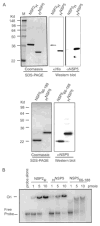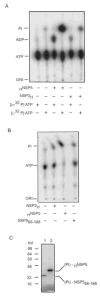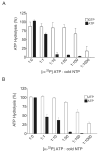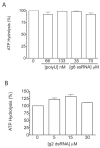An ATPase activity associated with the rotavirus phosphoprotein NSP5
- PMID: 17825341
- PMCID: PMC2702534
- DOI: 10.1016/j.virol.2007.07.029
An ATPase activity associated with the rotavirus phosphoprotein NSP5
Abstract
Interactions between NSP5 and NSP2 drive the formation of viroplasms, sites of genome replication and packaging in rotavirus-infected cells. The serine-threonine-rich NSP5 transitions between hypo- and hyper-phosphorylated isomers during the replication cycle. In this study, we determined that purified recombinant NSP5 has a Mg2+-dependent ATP-specific triphosphatase activity that generates free ADP and Pi (Vmax of 19.33 fmol of product/min/pmol of enzyme). The ATPase activity was correlated with low levels of NSP5 phosphorylation, suggestive of a possible link between ATP hydrolysis and an NSP5 autokinase activity. Mutagenesis showed that the critical residue (Ser67) needed for NSP5 hyperphosphorylation by cellular casein kinase-like enzymes has no role in the ATPase or autokinase activities of NSP5. Through its NDP kinase activity, the NSP2 octamer may support NSP5 phosphorylation by creating a constant source of ATP molecules for the autokinase activity of NSP5 and for cellular kinases associated with NSP5.
Figures









Similar articles
-
Viroplasms: Assembly and Functions of Rotavirus Replication Factories.Viruses. 2021 Jul 12;13(7):1349. doi: 10.3390/v13071349. Viruses. 2021. PMID: 34372555 Free PMC article. Review.
-
Histidine triad-like motif of the rotavirus NSP2 octamer mediates both RTPase and NTPase activities.J Mol Biol. 2006 Sep 22;362(3):539-54. doi: 10.1016/j.jmb.2006.07.050. Epub 2006 Jul 29. J Mol Biol. 2006. PMID: 16934294 Free PMC article.
-
Two non-structural rotavirus proteins, NSP2 and NSP5, form viroplasm-like structures in vivo.J Gen Virol. 1999 Feb;80 ( Pt 2):333-339. doi: 10.1099/0022-1317-80-2-333. J Gen Virol. 1999. PMID: 10073692
-
RNA-binding activity of the rotavirus phosphoprotein NSP5 includes affinity for double-stranded RNA.J Virol. 2002 May;76(10):5291-9. doi: 10.1128/jvi.76.10.5291-5299.2002. J Virol. 2002. PMID: 11967345 Free PMC article.
-
Nonstructural proteins involved in genome packaging and replication of rotaviruses and other members of the Reoviridae.Virus Res. 2004 Apr;101(1):57-66. doi: 10.1016/j.virusres.2003.12.006. Virus Res. 2004. PMID: 15010217 Review.
Cited by
-
Molecular characterization of the porcine group A rotavirus NSP2 and NSP5/6 genes from São Paulo State, Brazil, in 2011/12.ScientificWorldJournal. 2013 Jul 15;2013:241686. doi: 10.1155/2013/241686. eCollection 2013. ScientificWorldJournal. 2013. PMID: 23970830 Free PMC article.
-
The Role of the Host Cytoskeleton in the Formation and Dynamics of Rotavirus Viroplasms.Viruses. 2024 Apr 25;16(5):668. doi: 10.3390/v16050668. Viruses. 2024. PMID: 38793550 Free PMC article. Review.
-
Iron‑sulfur clusters in viral proteins: Exploring their elusive nature, roles and new avenues for targeting infections.Biochim Biophys Acta Mol Cell Res. 2024 Jun;1871(5):119723. doi: 10.1016/j.bbamcr.2024.119723. Epub 2024 Apr 8. Biochim Biophys Acta Mol Cell Res. 2024. PMID: 38599324 Free PMC article. Review.
-
In Situ Structures of the Polymerase Complex and RNA Genome Show How Aquareovirus Transcription Machineries Respond to Uncoating.J Virol. 2018 Oct 12;92(21):e00774-18. doi: 10.1128/JVI.00774-18. Print 2018 Nov 1. J Virol. 2018. PMID: 30068643 Free PMC article.
-
Viroplasms: Assembly and Functions of Rotavirus Replication Factories.Viruses. 2021 Jul 12;13(7):1349. doi: 10.3390/v13071349. Viruses. 2021. PMID: 34372555 Free PMC article. Review.
References
-
- Afrikanova I, Fabbretti E, Miozzo M, Burrone O. Rotavirus NSP5 phosphorylation is up-regulated by interaction with NSP2. J Gen Virol. 1998;79:2679–2686. - PubMed
-
- Afrikanova I, Miozzo M, Giambiagi S, Burrone O. Phosphorylation generates different forms of rotavirus NSP5. J Gen Virol. 1996;77:2059–2065. - PubMed
Publication types
MeSH terms
Substances
Grants and funding
LinkOut - more resources
Full Text Sources
Research Materials
Miscellaneous

